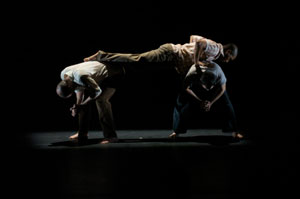13.) EXPLORING CAREERS AND LIFELONG LEARNING
Thinking and Writing about dance

One of the most interesting aspects of the incredible variety of contemporary dance is the fact that each dance establishes its own viewing priorities. That is to say that there is no one way to look at dance. A sensitive audience member will soon become aware of what and how the choreographer want us to watch. But it can also be helpful to know a little bit about the choreographers ideas and inspirations for the piece. (Which is exactly what this whole packet is trying to do for David Dorfman’s underground.) Dance critics and writers are people who believe in the power of dance and want to find ways to communicate that power through words so that more people can hear and appreciate this art form, even if they were not in the audience to see the dance. They may interview a choreographer, watch rehearsals of a dance before its premiere, or find out more about the collaboration between the composer and lighting designers, etc. Then they write about the dance with as much descriptive language as possible.
Classroom Activity: Writing Dance
Either present the students with dance reviews or have the students find two dance reviews from different sources such as The New York Times or Dance Magazine. Ask them to look for and highlight the author’s use of descriptive language. Ask them to write one paragraph which tries to describe a section of underground that they found particularly compelling.
Classroom Activity: Researching Careers
Have the students read the article about Alicia (a dancer turned Columbia University history student turned back to dancer) and discuss it in class. Ask them to list what areas of dance they would prefer to be involved in? These might include being a performer, choreographer, arts administrator, working in production and technical design (lighting, costume, set), critic, or simple an enthusiastic and informed audience member? See Pointe Taken

